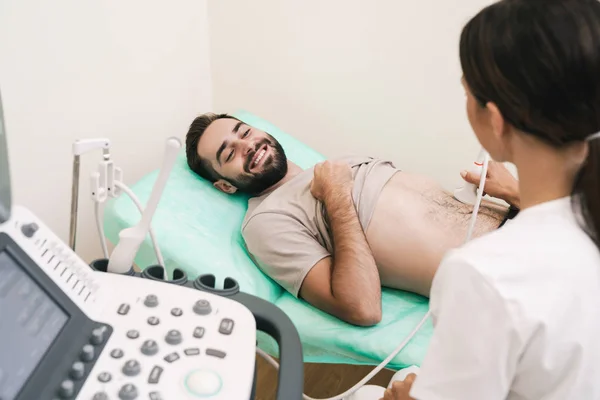The best pelviabdominal ultrasound at home in Egypt

Curexmed offers the best pelviabdominal ultrasound at home in Egypt. The pelviabdominal ultrasound is one of the most important ultrasound examinations, as it is concerned with scanning and evaluating the abdomen with ultrasound waves to see the various organs and tissues of the digestive system, scanning the urinary system, and blood vessels of the abdomen.
The abdominal ultrasound is a branch of pelvic ultrasound because it visualizes the organs inside the pelvic bones. The pelvic ultrasound is more comprehensive than the abdominal ultrasound because it can scan the abdomen, digestive system, urinary system, female organs and rectum.
Pelviabdominal ultrasound at home
Pelviabdominal ultrasound is an examination used to scan and evaluate vital organs inside the abdomen and pelvis: the digestive system organs such as the gallbladder, spleen, liver, and organs of the urinary system such as the kidneys and bladder, to diagnose many problems such as stones in the bile ducts, ureter, and bladder, or the presence of inflammation in any organ or other problems that will be explained in this article.
Mechanism of transabdominal ultrasound
The mechanism of ultrasound work depends on sending high-frequency ultrasound waves through a transducer connected to the device to the organ or tissue to be examined.
The nature of the response of each organ to those sound waves differs from one to another, Those waves reflected from the organs and the transducer receives them again. It analyzes the quantity and speed of those waves returned from the organs and shows the results on the screen in the form of a live image of the organs and tissues that are being examined.
Ultrasound gel is used and placed on the skin over the area to be examined to ensure smooth movement of the transducer and to get rid of air between the transducer and the skin to get the best results.
The importance of pelviabdominal ultrasound at home
transabdominal ultrasound at home diagnose many diseases and symptoms:
- The cause of abdominal pain.
- The cause of the fever.
- Monitoring and diagnosing. cancerous tumors.
- Diagnosis and treatment of fluid accumulation in the abdomen (ascites).
- The cause of kidney inflammation or infection in any other organ.
- The cause of swelling in one of the organs in the abdomen.
- Damage from accidents and injuries.
- Gallbladder and kidney stones.
- cysts and abscesses.
- Aortic aneurysm (AAA).
- clots in blood vessels.
- It is also a suitable diagnostic tool after obtaining abnormal results of liver or kidney function tests.
Why is abdominal ultrasound performed?
Book now abdominal ultrasound near me service from Curexmed without the need to go to any specialized radiology center or hospitals to diagnose many organs in the abdomen and pelvis area, such as:
1. Ultrasound on the liver
A liver ultrasound is used to diagnose:
- The presence of cysts or solid masses in the liver and the distinction between them.
- Liver diseases such as cirrhosis, hepatitis, and fatty liver.
- Cholecystitis and gallstones.
2. Ultrasound on the gallbladder
The gallbladder is usually examined during the liver ultrasound, and the gallbladder ultrasound is used to diagnose:
Abdominal pain in the upper right side, gallstones, cholecystitis, benign and malignant gallbladder tumors, gallbladder perforation, gallbladder polyps.
3. Ultrasound on the spleen
A spleen ultrasound is used to diagnose problems that may affect the spleen, such as:
Splenomegaly, accessory spleen, cysts, lymphomas, hematomas, splenic ruptures, splenic infarction, splenic masses (cystic or solid), benign and carcinomas.
4. Ultrasound on the pancreas
A pancreatic ultrasound is used to diagnose:
- The size of the pancreas and the diameter of the pancreatic duct, but it must be taken into account that the normal size of the pancreas is variable, and the increase in fat in the pancreas and the expansion of the pancreatic duct is normal with age.
- pancreatic tumors.
- Acute and chronic pancreatitis.
- Pancreatic cysts and pseudocysts.
5. Ultrasound on the kidneys
A kidney ultrasound is used to diagnose:
- The size, location, and shape of the kidneys, ureters, bladder, and residual urine.
- Cysts and abscess.
- Benign and malignant tumors.
- Infection or inflammation of the kidneys and bladder.
- Kidney and ureter stones.
6. Ultrasound of the aorta
Doctors usually order an abdominal aorta ultrasound to diagnose aortic obstruction or aortic aneurysm.
Aortic aneurysms usually occur due to the hardening of the artery or the accumulation of plaques, which weakens the walls of the aorta and make it swell. The more the artery swells, the more likely it is to burst or rupture, causing severe pain in the back or abdomen, nausea, and shortness of breath. So our doctor may ask for an AAA ultrasound to diagnose Aortic aneurysms.
7. Abdominal hernia ultrasound
The doctor may diagnose an abdominal hernia during a physical examination, but in many cases, the patient may suffer from symptoms of a hernia, but it is not discovered during the physical examination. In this case, the doctor asks to perform an ultrasound to diagnose abdominal hernias.
Abdominal hernia ultrasound can diagnose inguinal hernias, direct hernias, and indirect hernias, and the doctor may use other tests to confirm the diagnosis of abdominal hernias.
Pelviabdominal ultrasound results explained
- In the normal results of the pelviabdominal ultrasound, the organs that were examined appear naturally healthy, free of any problems or diseases.
- Abnormal results may differ from one organ to another. For example, the presence of:
- Blockage in the aorta or aneurysm are abnormal results of aorta ultrasound.
- Gallstones, inflammation of the gallbladder, liver tumors, cirrhosis, bile duct obstruction, or liver enlargement are abnormal results of liver and gallbladder ultrasound.
- Enlarged kidneys or stones in the kidneys, ureters, and bladder are abnormal results of kidney ultrasound.
- Pancreatitis and splenomegaly are abnormal findings of spleen and pancreas ultrasound.
Does a pelvic ultrasound show the bowel?
pelvic ultrasound can detect colitis and its complications, and is also used to distinguish between ulcerative colitis and Crohn’s disease based on the structure of the layers of the intestine, but it cannot be relied only on diagnosing colitis, and other diagnostic tools such as magnetic resonance must be used to reach the correct diagnosis.
Did abdominal ultrasound show stomach?
Abdominal ultrasound may be able to diagnose many stomach diseases such as hiatal hernia and stomach tumors, but it is not one of the common tests that doctors use to examine the stomach because of the difficulty of seeing the body and bottom of the stomach easily using ultrasound, so doctors usually resort to using the endoscope to obtain an accurate and correct diagnosis of the stomach.
What is pelviabdominal ultrasound preparation?
Preparation differs according to the type of organ to be examined:
- To study the spleen, pancreas, and liver, you should stop eating foods containing fat the day before the test and fast 8-12 hours before the test.
- fasting before gallbladder ultrasound for no less than 8-12 hours is necessary, and to abstain from fatty foods before the test.
- To study the kidneys: The doctor will recommend drinking at least 1-1.5 liters of water before the test to fill the bladder and may also recommend fasting 8-12 hours before the test to avoid the accumulation of gas in the intestines and affect the result of the test.
- For the study of the aorta: fasting from food and smoking 8-12 hours before the test.
What is the pelviabdominal ultrasound at home price?
The price of the best pelviabdominal ultrasound at home in Egypt varies according to several factors, such as the type of ultrasound examination required, the time of service request, and the geographical location of the applicant, but be sure that we offer you the best abdominal ultrasound near me service by the most skilled medical staff as soon as possible and at the lowest prices.






